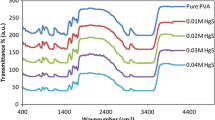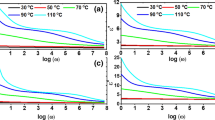Abstract
Here, we report the DC and AC electrical properties of polyvinyl alcohol (PVA)–selenium (Se) nanocomposite films in the temperature (T) range 298 K ≤ T ≤ 420 K and in the frequency (f) range 120 Hz ≤ f ≤ 1 MHz. The introduction of selenium nanoparticles into the PVA matrix slightly increases the values of DC conductivity whose temperature dependency obeys Vogel–Fulcher–Tammann law. The AC conductivity follows a power law with frequency in which the temperature dependence of the frequency exponent suggests that the correlated barrier hopping is the dominant charge transport mechanism for the nanocomposite films. Comparative discussions with Dyre’s random free-energy barrier model have also been made in this regard. The increase in AC conductivity with increase in nanoparticles concentration was also observed and attributed to the corresponding increase in conducting channels in the PVA matrix. The real part of the dielectric constant increases either with increase in temperature or with increase in selenium nanoparticles loading into the polymer matrix, which may be attributed to the enhancement of interfacial polarization. The frequency dispersion of the dielectric spectra has been modeled according to the modified Cole–Cole equation. Well-defined peaks were appeared in the plotting of imaginary part of electric modulus with frequency above room temperature, which was fitted with suitable equations to account for the deviations from ideal Debye-type behavior. Though the current–voltage characteristics are linear at smaller voltages, it appreciably becomes nonlinear at higher voltages. This nonlinearity has been accounted in light of Werner’s model and back to back Schottky diode model.











Similar content being viewed by others
References
Alivisatos AP (1996) Semiconductor clusters, nanocrystals, and quantum dots. Science 271:933–937
Haase MA, Qui J, DePuydt JM, Cheng H (1991) Blue-green laser diodes. Appl Phys Lett 59:1272–1274
Sinha S, Chatterjee SK, Ghosh J, Meikap AK (2013) Structural characterization and observation of variable range hopping conduction mechanism at high temperature in CdSe quantum dot solids. J Appl Phys 113:093703
Schlamp MC, Peng XG, Alivisatos AP (1997) Improved efficiencies in light emitting diodes made with CdSe(CdS) core/shell type nanocrystals and a semiconducting polymer. J Appl Phys 82:5837
Sargent EH (2009) Infrared photovoltaics made by solution processing. Nat Photonics 3:325–331
Genovese MP, Lightcap IV, Kamat PV (2012) Sun-believable solar paint. A transformative one-step approach for designing nanocrystalline solar cells. ACS Nano 6:865–872
Berger LI (1997) Semiconductor materials. CRC Press, Boca Raton FL, p 198–203
Sinha S, Chatterjee SK, Ghosh J, Meikap AK (2013) Semiconducting selenium nanoparticles: Structural, electrical characterization, and formation of a back-to-back Schottky diode device. J Appl Phys 113:123704
Hasan A, El Sayed AM, Morsi WM, El-Sayed S (2012) Influence of Cr2O3 nanoparticles on the physical properties of polyvinyl alcohol. J Appl Phys 112:093525
Bouzerara R, Achour S, Tabet N, Zerkout S (2011) Synthesis and characterization of ZnO/PVA composite nanofibres by electrospinning. Int J Nanopart 4:10–19
Zhang FM, Chang J, Eberhard B (2010) Dissolution of poly(vinyl alcohol)-modified carbon nanotubes in a buffer solution. New Carbon Mater 25:241–247
Hanafy TA (2012) Dielectric relaxation and alternating current conductivity of lanthanum, gadolinium, and erbium-polyvinyl alcohol doped films. J Appl Phys 112:034102
Mondal SP, Aluguri R, Ray SK (2009) Dielectric and transport properties of carbon nanotube–CdS nanostructures embedded in polyvinyl alcohol matrix. J Appl Phys 105:114317
Bhadra D, Sannigrahi J, Chaudhuri BK, Sakata H (2012) Enhancement of the transport and dielectric properties of graphite oxide nanoplatelets-polyvinyl alcohol composite showing low percolation threshold. Polym Compos 33:436–442
Senthil V, Badapanda T, Chithambararaj A, Bose AC, Mohapatra AK, Panigrahi S (2012) Dielectric relaxation behavior and electrical conduction mechanism in polymer-ceramic composites based on Sr modified Barium Zirconium Titanate ceramic. J Polym Res 19:9898
Senthil V, Badapanda T, Kumar SN, Kumar P, Panigrahi S (2012) Relaxation and conduction mechanism of PVA: BYZT polymer composites by impedance spectroscopy. J Polym Res 19:9838
Fernandes DM, Hechenleitner AAW, Lima SM, Andrade LHC, Caires ARL, Pineda EAG (2011) Preparation, characterization, and photoluminescence study of PVA/ZnO nanocomposite films. Mater Chem Phys 128:371–376
Chakraborty G, Gupta K, Meikap AK, Babu R, Blau WJ (2011) Anomalous electrical transport properties of polyvinyl alcohol-multiwall carbon nanotubes composites below room temperature. J Appl Phys 109:033707
Gandhi S, Nagalakshmi N, Baskaran I, Dhanalakshmi V, Gopinathan Nair MR, Anbarasan R (2010) Synthesis and characterization of nano-sized NiO and its surface catalytic effect on poly(vinyl alcohol). J Appl Polym Sci 118:1666–1674
Mahmoud WE, Al-Ghamdi AA (2010) The influence of vanadium pentoxide on the structure and dielectric properties of poly(vinyl alcohol). Polym Int 59:1282–1288
Abdelaziz M, Ghannam MM (2010) Influence of titanium chloride addition on the optical and dielectric properties of PVA films. Phys B 405:958–964
Sinha S, Chatterjee SK, Ghosh J, Meikap AK (2014) Dielectric relaxation and ac conductivity behaviour of polyvinyl alcohol–HgSe quantum dot hybrid films. J Phys D Appl Phys 47:275301
Mahendia S, Tomar AK, Kumar S (2010) Electrical conductivity and dielectric spectroscopic studies of PVA–Ag nanocomposite films. J Alloys Compd 508:406–411
Bhajantri RF, Ravindrachary V, Harisha A, Crasta V, Nayak SP, Poojary B (2006) Microstructural studies on BaCl2 doped poly(vinyl alcohol). Polymer 47:3591–3598
Lunkenheimer P, Bobnar V, Pronin AV, Ritus AI, Volkov AA, Loidl A (2002) Origin of apparent colossal dielectric constants. Phys Rev B 66:052105
El-kader FHA, Osman WH, Mahmoud KH, Basha MAF (2008) Dielectric investigations and ac conductivity of polyvinyl alcohol films doped with europium and terbium chloride. Phys B 403:3473–3484
Yakuphanoglua F, Aydogdua Y, Schatzschneiderb U, Rentschlerb E (2003) Electrical conductivity, dielectric permittivity and thermal properties of the compound aqua [bis(2-dimethylaminomethyl-4-NIT-phenolato)] copper(II) including NaCl impurity. Phys B 334:443–450
Cole KS, Cole RH (1941) Dispersion and absorption in dielectrics I. Alternating current characteristics. J Chem Phys 9:342
Tandon RP, Hotchandani S (2001) Electrical conductivity of semiconducting tungsten oxide glasses. Phys Status Solidi A 185:453–460
Thongbai P, Tangwancharoen S, Yamwong T, Maensiri S (2008) Dielectric relaxation and dielectric response mechanism in (Li, Ti)-doped NiO ceramics. J Phys Condens Matter 20:395227
Asami K (2002) Characterization of heterogeneous systems by dielectric spectroscopy. Prog Polym Sci 27:1617–1659
Psarras GC, Manolakaki E, Tsangaris GM (2002) Electrical relaxations in polymeric particulate composites of epoxy resin and metal particles. Compos A 33:375–384
Ioannou G, Patsidis A, Psarras GC (2011) Dielectric and functional properties of polymer matrix/ZnO/BaTiO3 hybrid composites. Compos A 42:104–110
Jonscher AK (1983) Dielectric relaxation in solids. Chelsea Dielectric Press, London, p 316
Almond DP, Hunter CC, West AR (1984) The extraction of ionic conductivities and hopping rates from ac conductivity data. J Mater Sci 19:3236–3248
Jonscher AK (1977) The ‘universal’ dielectric response. Nature 267:673–679
Long AR (1982) Frequency-dependent loss in amorphous semiconductors. Adv Phys 31:553–637
Austin IG, Mott NF (1969) Polarons in crystalline and non-crystalline materials. Adv Phys 18:41–102
Elliott SR (1987) Ac conduction in amorphous chalcogenide and pnictide semiconductors. Adv Phys 36:135–217
Austin IG, Mott NF (1969) Polarons in crystalline and non-crystalline materials. Adv Phys 18:41–102
Dyre JC (1988) The random free-energy barrier model for ac conduction in disordered solids. J Appl Phys 64:2456
Psarras GC (2006) Hopping conductivity in polymer matrix–metal particles composites. Compos A 37:1545–1553
McCrum NG, Read BE, Williams G (1967) An elastic and dielectric effects in polymeric solids. Wiley, New York, pp 180–182
Kim JS (2001) Electric modulus spectroscopy of lithium tetraborate (Li2B4O7) single crystal. J Phys Soc Jpn 70:3129–3133
Gonzalez-Campos JB et al (2012) Revisiting the thermal relaxations of poly(vinyl alcohol). J Appl Polym Sci 125:4082–4090
González-Campos JB, Prokhorov E, Sanchez IC et al (2012) Molecular dynamics analysis of PVA-AgnP composites by dielectric spectroscopy. J Nanomater 2012:11. doi:10.1155/2012/925750
Macedo PB, Moynihan CT, Bose R (1972) The long time aspects of this correlation function, which are obtainable by bridge techniques at temperatures approaching the glass transition. Phys Chem Glasses 13:171–176
Bergman R (2000) General susceptibility functions for relaxations in disordered systems. J Appl Phys 88:1356
Sinha S, Chatterjee SK, Ghosh J, Meikap AK (2014) Anomalous electrical transport properties of CdSe quantum dots at and below room temperature. Phys B 438:70–77
Linares A, Nogales A, Rueda DR, Ezquerra TA (2007) Molecular dynamics in PVDF/PVA blends as revealed by dielectric loss spectroscopy. J Polym Sci Part B Polym Phys 45:1653–1661
Upadhyay J, Kumar A (2014) Investigation of structural, thermal and dielectric properties of polypyrrole nanotubes tailoring with silver nanoparticles. Compos Sci Technol 97:55–62
Sze SM (1981) Physics of semiconductor devices, 2nd edn. Wiley, New York, p 119
Aubry V, Meyer F (1994) Schottky diodes with high series resistance: limitations of forward I–V methods. J Appl Phys 76:7973–7984
Werner JH (1988) Schottky barrier and pn-junction I/V plots—small signal evaluation. Appl Phys A 47:291–300
Chiquito AJ et al (2012) Back-to-back Schottky diodes: the generalization of the diode theory in analysis and extraction of electrical parameters of nanodevices. J Phys Condens Matter 24:225
Acknowledgements
Jiten Ghosh would like to thank Director CSIR-CGCRI for giving the permission for collaborative work with the team. The authors are thankful to MHRD, Government of India for the support during the project. We also gratefully acknowledge the support received from Centre of Excellence, TEQIP –II during the work.
Author information
Authors and Affiliations
Corresponding author
Rights and permissions
About this article
Cite this article
Sinha, S., Chatterjee, S.K., Ghosh, J. et al. Electrical transport properties of polyvinyl alcohol–selenium nanocomposite films at and above room temperature. J Mater Sci 50, 1632–1645 (2015). https://doi.org/10.1007/s10853-014-8724-z
Received:
Accepted:
Published:
Issue Date:
DOI: https://doi.org/10.1007/s10853-014-8724-z




